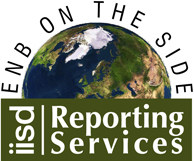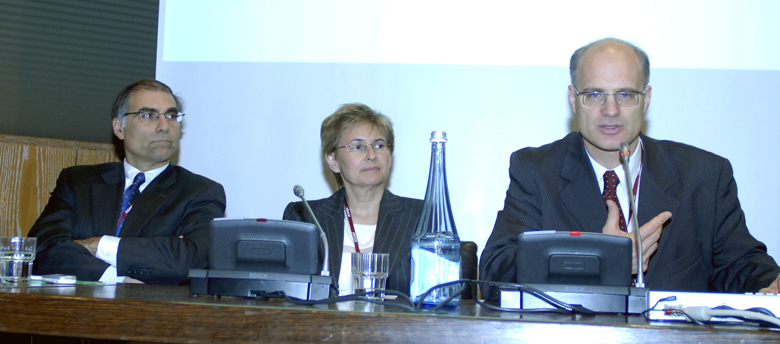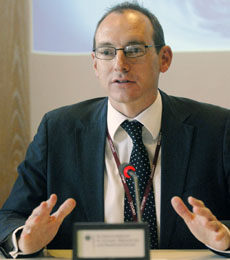 |
||
|
Published by the International Institute for Sustainable Development (IISD)
|
|||
|
A Special Report on Selected Side Events at the twenty-sixth sessions of the Subsidiary Bodies (SB 26) of the United Nations Framework Convention on Climate Change (UNFCCC)
|
|||||
| 7-18 May 2007 | Bonn, Germany | |||||
 |
|||
 |
|||
Events convened on Wednesday, 9 May 2007
|
World Bank update on climate change and carbon finance Presented by the World Bank |
|||
|
Johannes Heister, World Bank Carbon Finance Unit, emphasized that the World Bank’s existing carbon funds’ and facilities’ objectives were, inter alia, to catalyze the carbon market and “crowd in” the private sector. Heister said the World Bank carbon finance activities contributed to confidence in transactions and demonstrated the importance of: public-private partnerships; the early creation of demand; and flexibility. He underscored the need for progress in many countries’ regulatory systems, the long lead-times for projects and methodologies, and the difficulty of matching buying and selling interest.
Mahua Acharya, World Bank Carbon Finance Unit, introduced two proposed carbon facilities, explaining that their mission would be to promote low carbon growth by employing longer-term thinking and moving away from a project-by-project framework. On the first proposed facility, for purchasing emission reductions post-2012, she said that they envisioned a partnership of buyers and sellers that would identify programmes and mobilize investment. She emphasized that flexibility was essential. On the second proposed facility, Heister said it would address deforestation through the preparation of a system of positive financial incentives, including through capacity building and pilot performance-based payments. Noting the variable opportunity costs implied by different possible projects, he said the proposed facility would seek to “pick low-hanging fruit first.” Marcela Main, Department of Foreign Affairs, Chile, presented host-country perspectives on the proposed facilities, emphasizing the host-country view that avoiding, rather than reducing, emissions should be prioritized. Main said host-countries: viewed the World Bank’s role in increasing certainty to be critical; encouraged a focus on the energy and transportation sectors; and expressed concern with the possibility of complicating the dynamics of private sector engagement. |
|||
|
|||
|
UK-India Collaboration to identify the barriers to the transfer of low carbon energy technology Presented by the United Kingdom |
|||
|
Chris Dodwell, Department for Environment, Food and Rural Affairs (DEFRA), UK, noted that the aim of the UK-India Collaboration was to assist in achieving a new approach to international cooperation in developing low carbon energy options in the area of clean alternatives. He said that the collaborative study that results from this cooperation looks at specific elements of technology transfer and the role of international cooperation in overcoming barriers. Dodwell underscored that while the study is focused in India, it also provides a bottom-up approach to technology transfer that could inform broader discussions in other developing countries.
David Ockwell, University of Sussex, noted that technology transfer is playing a stronger role in the climate change negotiations, but that barriers remain. He recalled the rationale for technology transfer, including targeting future greenhouse gas (GHG) emissions from rapid developing economies. Highlighting that China is forecasted to surpass US levels of GHG emissions by 2010 and that India is expected to do so by 2030, he stressed the importance of supporting low carbon growth. Ockwell noted that the study analyzed case studies on coal gasification, LED lighting, biomass, hybrid vehicles and improving combustion efficiency. Summarizing key policy considerations for low carbon technology transfer, he said that: there is no “one policy fits all” solution; technology transfer between countries is as important as transfers from the research and development (R&D) stage to commercialization; technology transfer must take place as part of a wider process of technological capacity building; and there is a need to foster knowledge flows that contribute to the accumulation of technological capacity. Ockwell flagged intellectual property rights (IPRs) as one of the barriers for successful technology transfer, while noting that in the case of LED lighting in India, the greater barrier was not IPRs, but insufficient capacity. Ockwell pointed out to the need to have a national policy environment in the receiving country that encourages the role of such technology. In the ensuing discussion, participants debated, inter alia: the ability of the study to be applied to other developing countries that are not growing as fast as China and India; the dangers of transferring a type of technology that is not mature enough to assist the receiving country; the critical need for more empirical research in smaller countries; and availability of funds. |
|||
|
|||
|
||
|
Click the above button to go back to our ENB main coverage
|
||
|
|
|
|
|
||
|




